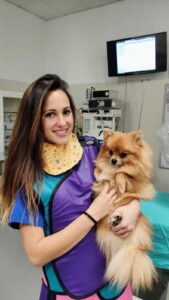
Introduction
Neutered male Pomeranian, 5 years old. He presented with coughing symptoms of more than 1 year of evolution, increased during times of excitement and some nights. He presented constant panting and intermittent snoring, however, the owners did not point out any intolerance to exercise.
A diagnosis of tracheal collapse was made by fluoroscopy under cough reflex of tracheal collapse. Endoscopically it was classified as grade II-III depending on the tracheal segment (cervical/intrathoracic). No bronchial involvement.
Description of the procedure
Due to his age and clinical condition, the patient was not suitable for traditional stent implantation. After informing the guardian about the possibility of TwineStent implantation and the reversible nature of the procedure, it was decided to proceed.
The prosthesis was implanted over the entire tracheal length. The TwineStent was inserted with the technique described as Twining without problem and fixed to the cranial tracheal ring with a 5-0 non-absorbable suture. Because the prosthesis was 1 cm longer than desired, an extratracheal loop (fixed with the suture) was left in place.
Medication with oral and inhaled corticosteroids, antitussives and antibiotics was prescribed as recommended, ending 21 days post-intervention.
Result
Immediately after the operation, the patient showed no respiratory disturbance. All medication could be withdrawn without any problems after 21 days.
Currently, the patient has not been on medication for three years and has no symptoms associated with tracheal collapse.
ConclusionThe use of the TwineStent tracheal stent proved to be a safe and effective therapeutic option for tracheal collapse. The possibility of removing the prosthesis made it possible to operate on a young patient with a low degree of tracheal collapse thanks to the safety of the device.
Practitioner's comments. "The use of the TwineStent is a long-term alternative in animals with a low degree of tracheal collapse".


